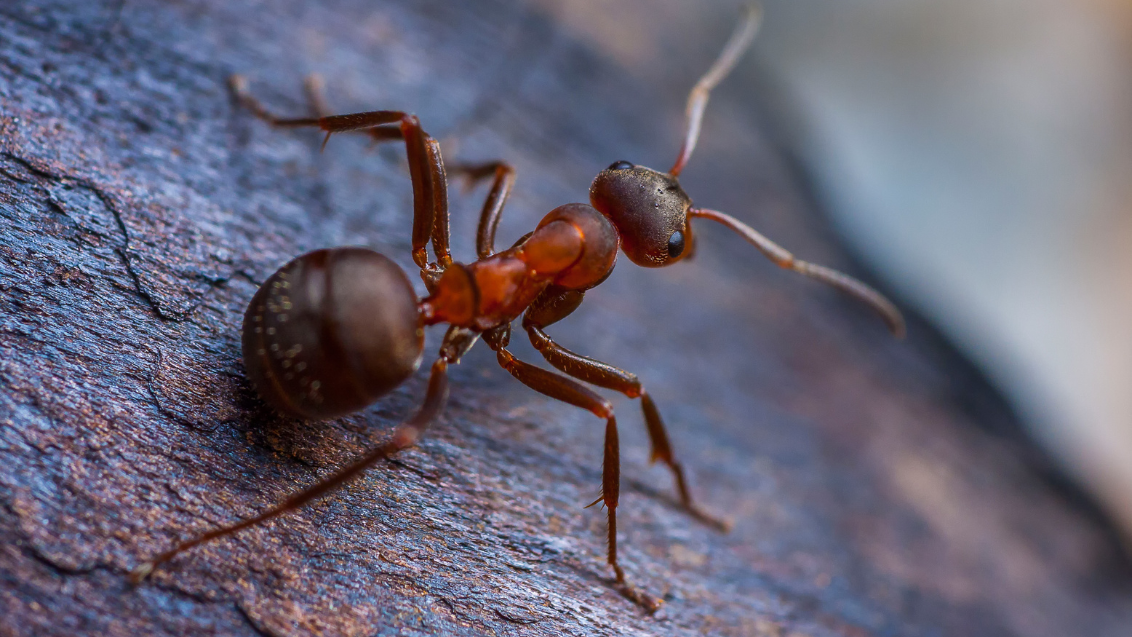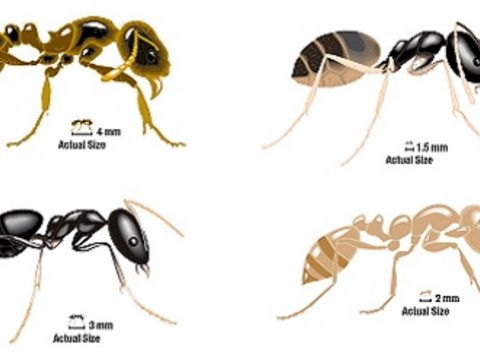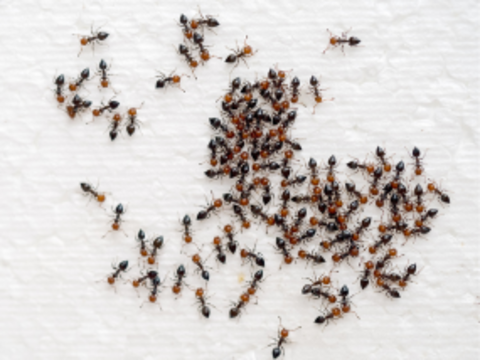The Six Species of Ants you Need to Know

Different ant species have different behaviours, which can impact the level of control you will achieve.
Some ant species live in colonies that are supported by a single queen; others, for example, polygynous species like Pharaoh Ants and Argentine Ants, are supported by multiple queens. Polygynous ants rapidly construct new nests, which means houses can be under attack by numerous nests. In this situation, total long-term control will not be possible. You will need to advise your customer that regular retreatments are required to ensure their homes have minimal interruption from ants.
Although there are 1,300 ant species known in Australia, there are relatively few that we commonly see as pests. To assist you, here is a list of six common ants you may encounter when responding to a customer call.
Argentine Ant (Linepithema humile)

- Light to dark brown in colour Argentine Ants bite instead of sting, and drive out other ant species in an area
- Workers are about 1.6 mm long, are produced in spring and increase in numbers up until autumn. They follow food trails for long distances, so nests are not easy to track
- Winged ants (reproductive kings and queens) are produced in early spring before the workers. They mature within three months and mate soon afterwards
- Mate in their nests, so no swarming is seen
- Prefer sweet foods but will also eat live and dead insects, meats, cereals and damaged fruit
Black Ant (Lasius niger)

- Dark brown-black in colour with one small segment at waist point (pedicel) and no sting
- Queens, which are 15 mm long, overwinter in soil
- Eggs are laid in late spring and larvae hatch 3-4 weeks later, then feed on secretions from the queen’s salivary glands until the first worker ants emerge
- Worker ants, which are 4-5 mm long, continue with larval care, nest building and food foraging. They follow well–defined trails around food sources. Sweet foods are preferred but high protein foods will also be taken.
- Fertile males are produced later in the season. Mating between queens and fertile males takes place mid to late summer
- Nests are often located outdoors in soil and below paving slabs on the sunny side of buildings. They can be identified by the presence of finely powdered soil around nest exit holes
Coastal Brown Ant (Pheidole megacephala)

- Yellow brown to brown, about 1.5-2.5 mm long.Eggs laid are small in size. Larvae are fed by the adults and after several moults, the larvae pupate
- Adults are made up of 3 different castes: wingless workers that build the nest, supply food, feed larvae, look after eggs and defend the nest; winged males who mate with the females, and winged females – the largest in size and reproductive queen of the colony, living for many years
- Nest in soil along pathways around the house, including gardens and walls
- Excavates and leaves unsightly mounds along foot paths and other areas
- Attacks foods around the property including meat, sweets, fruit and greasy foods
Odorous Ant (Tapinoma sessile)

- Brown or black, 1.59 mm-3.18 mm long with six legs, antennae have 12 segments and are not terminated with a club
- Produce a coconut smell when crushed
- Time to adult phase of development is 34-38 days, and they typically live for several years.
- Eat pet food and most household foods, especially sugary food, sweets and fruits
- Attracted to moisture. In hot, dry environments, nests can be found in house plants and even lids of toilets
- Colonies range in size from 100 to 10,000 ants
Pharaoh Ant (Monomorium pharaonis)

- Black eyes with two small segments at the pedicel. Workers are 1.5-2 mm long and yellow-brown with a brown abdomen; males are 3 mm long, black and winged; queens are 3.5-6 mm long, dark red with wings.
- Live in multi-queen colonies; swarming can take place at any time of the year
- Winged adults seldom fly, so are rarely seen. Wings are soon lost after mating
- Feed indoors on high protein foods such as meat, fats, blood and dead insects
- New colonies are often formed through nests that have been disturbed, for example, as a result of insecticide spray treatments
- Lays well–defined trails, often associated with heating systems. Nests are located in deep cavities in heated buildings. They are often found in hospitals and places associated with humid conditions
- Colonies can range from a few dozen to 300,000 individuals
Whitefooted Ant (Technomyrmex difficilis)

- Dark brownish and black colour with yellow-white feet and around 3 mm in length, these ants are invasive and can be hard to eradicate. A colony has huge reproductive capabilities and can contain up to a million ants
- Tend to spread out into satellite colonies which nest in different locations
- Ideal nesting locations include trees - in trunks or galleries that might have once been created by termites, under loose bark or plant debris, nearer the home in attics, under roof shingles, in wall voids, along fences and in outdoor furniture
- Indoors, they can be found in the kitchen area near bins or where food is stored or prepared
- Attracted to sweet substances such as plant nectars, flowers, sweet human foods, aphids and mealy bugs which secrete honeydew
- Often seen foraging for food in large numbers, usually at night if temperatures are high
Tips for Effective Treatment
Once you’ve identified the ant species, locating common ingress points is key to choosing the right treatment program for your customer’s ant problem.
Other than obvious points such as windows and doors, a dwelling’s construction method can provide ants with numerous ingress points, such as wood voids, pipe entry points, slab joins and conduits. Ants are also generally attracted to moisture, which means you are likely to find the source of the ants – that is, nests and ants runs – is located near plumbing or garden beds.
So, once you’ve identified your species and located the ingress points, what products will produce the most effective result? This will depend on your application. To get you started, here are some options for common treatments.
Indoor treatment
Trails and their surrounding areas can be spot-treated with ARILON: a non-repellent insecticide. If trails are located with a strong population of ants, OPTIGARD Ant or ADVION Ant gel baits can be used immediately adjacent to, or in cracks and crevices in the areas where ants are or have recently been seen.
Sometimes, it may be necessary to treat entry points to deter foraging (or scout) ants indoors, such as areas around doors and windows frames, weep holes or even in subfloors and under the eaves and awnings. DEMAND is ideal in these situations.
Outdoor baiting and spot treatments
An ideal way of treating ant infestations is offering an alternative food source by applying OPTIGARD Ant Gel or ADVION Ant Gel immediately adjacent to the foraging trails outside of a structure. Ants will ingest the liquid component of the gel, or physically take the solid component back into the nest for further feeding (and insecticide transfer) to nest mates.
For direct nest spot treatments, liberally treat nest areas and ant colonies with DEMAND liquid insecticide. For sparse ant activities that may be linked, treat soil surfaces with ARILON. Inspect garden beds, landscape ornamentals and plants – such as palms and succulents – that are close to the home as sources for water and food. Items such as fertiliser, manure, flowers or plants with naturally occurring sticky sap can also be a commonly overlooked as a source of sustenance for ants.
Caution should be taken with other native and non-native pollinators, for example, wasps, butterflies and bees. Other insects such as honeydew-producing insects, can also attract and encourage ant populations. These tertiary insects may need a differing treatment approach, so be sure to consult the product label or a local horticulturalist.
Perimeter application
DEMAND insecticide is very effective as perimeter treatment, which is extremely helpful when ants are trailing from adjacent properties or structures. When applied at recommended rates, DEMAND creates a complete control band around a structure by releasing more than 10,000 microcaps per square inch of a treated surface. ARILON is also effective as a large-volume application. It can be diluted and applied at high volumes to provide comprehensive coverage, resulting in a more thorough control.



